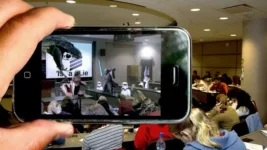Ever since the first computing machines were made, games were an integral part of computer development. I am sure even the ancient Babylonians had found a way to play with their abacuses (abaci) during their lunch break.
The first video game is believed to have been a tennis game, similar to pong, developed on an oscilloscope. Since then technology has come a long way, where we used to be happy playing Snake on our Nokia phones, now the best 3D graphics are hardly good enough. Even prominent casino sites like M88 for example are constantly using the latest state of the art technology to improve player experience and keep players engaged.

Screenshot Pong (then) compared to MU: Origin (now)
Year for year screens have become better and processors faster but now developers have squeezed nearly everything they could out of mobile screens, so they need something new to keep us excited and the hard-and software industry on their feet, here are a few of the latest trends.
Immersion
Virtual reality with the help of a VR headset is the closest we can get to an immersive experience at the moment, although the utmost and true immersive experience would be the famous Star Trek Holodeck, if it should ever exist.

With affordable entry-level headsets flooding the market and the introduction of top hardware, like the Oculus Rift, VR definitely had a good year.
Wearing a bulky headset and blindly dancing around a room or the subway is not ideal, but with its growing popularity the VR industry is working on lighter and more practical solutions for VR hungry consumers. Microsoft’s IlumiRoom, where the console projects the game’s environment on the walls around your screen, could be an alternative but the experience and the quality of the projections cannot compete with the VR experience when using a headset.
Augmented Reality
This also could count as an art immersive experience, to put it into Wikipedia’s words
Augmented reality (AR) is a live direct or indirect view of a physical, real-world environment whose elements are augmented (or supplemented) by computer-generated sensory input such as sound, video, graphics or GPS data.
At least since the surprising success of Pokemon Go, everyone has an idea what augmented reality is or could be. Pokemon Go was just the beginning, Microsoft’s Hololens and (maybe) a relaunch of Google Glass will eventually give AR the real boost that it needs.

(Photo courtesy Microsoft)
With augmented reality and the possibility to engage with your environment, game developers will be able to take multi-player games to a whole new level, introducing a new era of gameplay and accessories to the market.
Using the technology is more practical than VR, since you stay in touch with your surroundings and augmented reality can be used in nearly every situation, like gaming, education, work, navigation, tourism and even cooking; making the investment in the necessary hardware more attractive for potential customers.
After the initial flop of Google Glass, the VR hype is helping augmented reality find more acceptance in the general public, giving it the potential to replace smartphones and become the next big thing. We just have to get used to everyone wearing glasses instead of staring at the palm of their hands.
The Cloud
With wireless connections becoming more efficient, faster and cheaper by the day, the next logical step would be to go back to the old concept of mainframes and peripherals. Instead of trying to fit a desktop into your pocket the trend is letting the cloud do the big calculations for graphic intense games, VR or AR, and a not so smart peripheral device only delivering the result.
A good example is the Google Chrome experiment Lightsaber Escape. You use your phone to control the lightsaber and deflect blaster shots like the jedi in the Star Wars movies and play on your Chrome browser, with no need for expensive hardware.

Screenshot “Lightsaber Escape”
It’s more an experiment than sophisticated game play but it gives you an idea of the potential and the direction online games could take.
The cloud is the future of gaming with already numerous game streaming or online gaming platforms on the internet, even office programs and operating systems (Chrome OS) have moved to the cloud. Without really realizing it nearly our whole lives (pictures, documents, contacts etc.) are already stored in the cloud.








